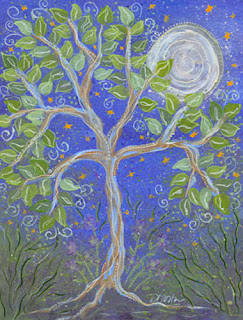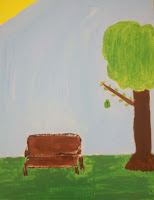As we enter a time of more nighttime, owls are more likely to be spotted since they hunt at night since most are nocturnal. We learned about different features of owls that make them unique including their huge, staring eyes and their little ears that provide them with their keen hearing. The children also agreed that while they're cute, owls can be quite scary, especially since they have the ability to fly almost silently. We talked about how their soft flight feathers muffle the sound of their wings making them excellent nighttime hunters.
This project was completed in one hour and used the following materials:
18"x12" Dark Blue Construction Paper
Oil Pastels-white, yellow, and black
Scraps of owl colors-brown, gray, white, black, orange, yellow
Precut circles in various sizes for the eyes (older students can cut their own!)
White glue
Scissors
1. To begin students learned how suprisingly simple it was to draw an owl. With black pastel start with two large circles for the eyes, add a triangle beak, then a head with little pointy ears. Next add a large "U" for the body, and then legs and talons (the students loved this word!). The wings can be drawn spread out in flight or perched. A branch could be added if the students wanted to.
2. White and yellow oil pastels were used to add stars, a moon, and/or clouds to the dark blue sky.
3. Owl colored paper scraps were torn to make up the feathers of the owl. We did the body and head the same color first, then the wings a different color (this helps them stand out). Glue was added to the areas in sections and the feathers were added to cover all the blue paper.
4. Next students selected 3 different sized circles for the eyes (some chose to cut their own out). These were layed with the smallest on the top and largest on the bottom. The eyes are the most important part of the owl so they have to stand out!
5. Beaks and legs were either cut or torn and then glued on. The branch was also covered in torn paper at this time.
The students had a blast creating these very special owls and were proud to show them to their parents!

























































